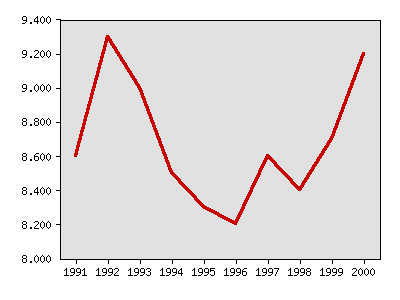What were things like in 2002?
The following idicator summary is from the 2002 Minnesota Milestones and does not neccessarily reflect the current data trends.
Indicator : Child abuse and neglect
Rationale: The risks of child abuse and neglect include physical injury, emotional illness, poor school performance and future criminal behavior.
About this indicator: The rate of child abuse and neglect has changed only slightly during the last decade. This includes cases of child abuse and neglect as a proportion of the under-18 population. The statistics are based on reports of neglect or abuse that are determined by the local welfare agency to be maltreatment. The rate has fluctuated between 8.2 and 9.3 per 1,000 since 1991, but increased 9.5 percent between 1998 and 2000. The rate of 9.2 abused or neglected children per 1,000 in year 2000 includes individual children for whom abuse was determined more than once. Looking at unique victims of determined maltreatment, the rate was 8.7 per 1,000 children.
In 2000, maltreatment was determined in just under half of the reports alleging abuse. The majority of determined cases were for neglect, followed in frequency by physical abuse, sexual abuse and mental injury.
Children age 10 and under represented the majority of victims of neglect. Over three-quarters of sexual abuse victims were girls. The rate of determined cases of abuse and neglect was more than seven times greater for Black/African American children and eight times greater for American Indian children than for non-Hispanic White children, though the gap is smaller than in 1999. The majority of abusers were the child's birth parents. Neglected children were more likely to live in a family experiencing multiple family issues including substance abuse.
Eighteen children are known to have died from maltreatment in 2000, a reduction from 28 in 1999. Of these, 13 children died from physical abuse and five from neglect. In 1998, only three deaths from maltreatment were recorded. According to the Minnesota Department of Human Services, improvements in reporting procedures may account for some or all of the difference between 1998 and 1999.
Abused or neglected children, per 1,000 children under age 18

Abused or neglected children, per 1,000 children under age 18
| Year | Data |
|---|
| Abused or neglected children, per 1,000 children under age 18, Minnesota Department of Human Services
|
|
1991 |
8.6 |
|
1992 |
9.3 |
|
1993 |
9.0 |
|
1994 |
8.5 |
|
1995 |
8.3 |
|
1996 |
8.2 |
|
1997 |
8.6 |
|
1998 |
8.4 |
|
1999 |
8.7 |
|
2000 |
9.2 |
For comparison: The incidence of child abuse and neglect is difficult to compare among states due to varying definitions and reporting practices.
Things to think about: In 2000, most of the 17,408 alleged maltreatment reports received a traditional child-protection response, requiring a judgment on whether a determination should be made. Over 900 cases in 20 counties were addressed through Alternative Response, a strengths-based community approach to addressing child maltreatment. With this new approach, no official determination is made, but a family assessment ascertains the family needs and strengths, the safety of the child and the risk of maltreatment. Intensive support services are offered to families at higher risk. Under this approach, fewer determinations may be recorded, but more families may receive help.
Technical notes: Comparisons of abuse and neglect rates throughout the decade should be treated with caution. Changes in case management, such as the increased emphasis on family support rather than determination, may reduce the number of determined cases recorded in the future. [Lincoln, Lyon and Murray counties merged their child protection systems in 1999. Faribault and Martin counties merged their systems in the same year.] County data is based on three year averages.
Sources:
Minnesota Department of Human Services, Children's Research, Planning and Evaluation Division and the Family and Children's Services Division, Child Maltreatment: A Minnesota Report, www.dhs.state.mn.us
Related 2002 Milestones indicator:
Other related indicators:
- Number and rate of children needing child protective services (Minnesota Department of Human Services, www.dhs.state.mn.us).
- Number of reports and child victims by maltreatment type (Minnesota Department of Human Services, www.dhs.state.mn.us)
Local data:
County level data:


Milestones is a product of the Minnesota State Demographic Center, a division of the Department of Administration






